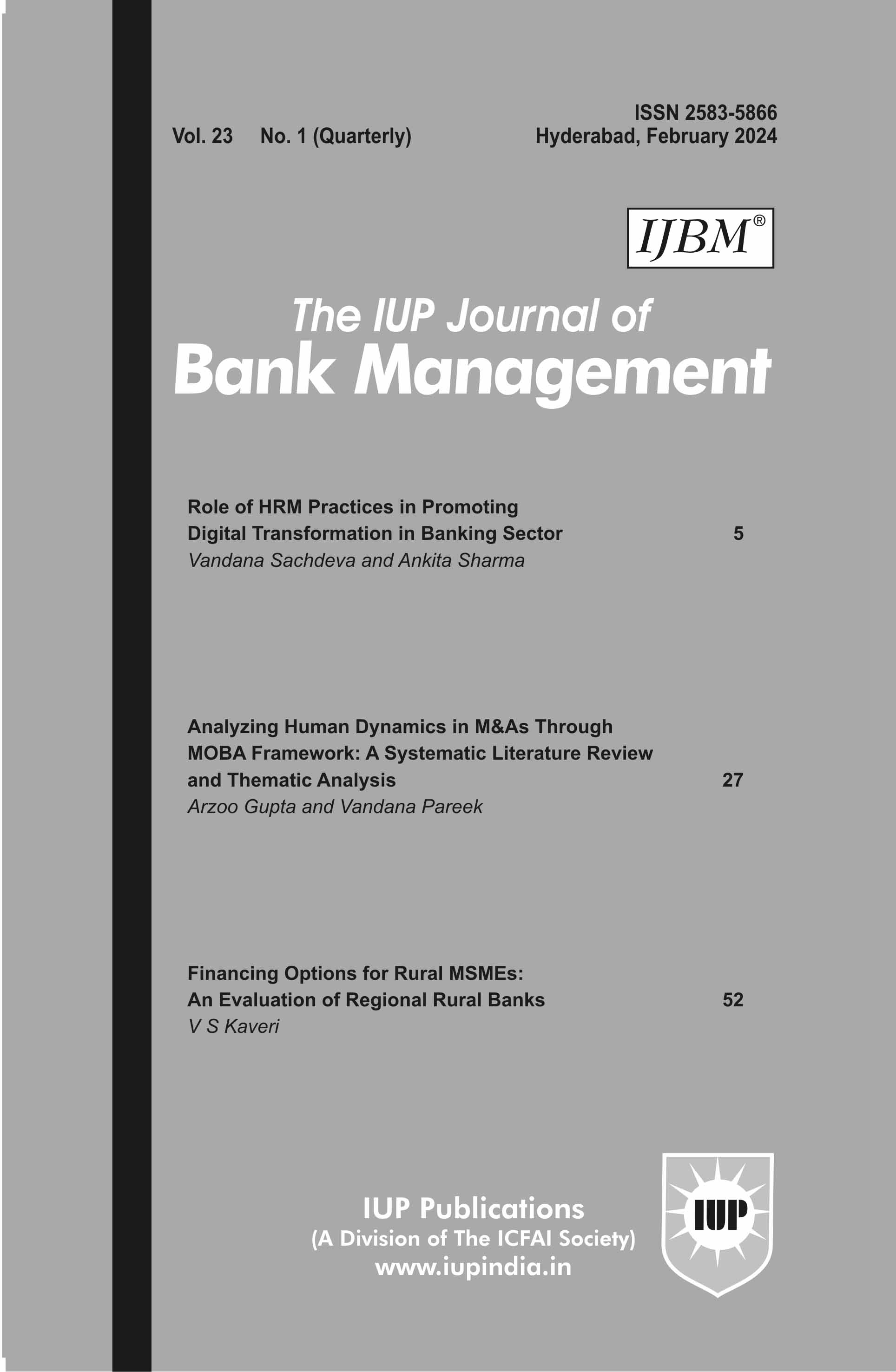
Feb'24
|
|
The IUP Journal of Bank Management
ISSN: 2583-5866
A "peer-reviewed" journal included in EBSCO and ProQuest (Part of Clarivate) Database
Management is a quarterly journal that focuses on risk management, forex markets, retail banking, HRD and leadership, banking, supervision, convergence of financial services and E-Banking.
|
|
|||
| Article | Price (₹) | ||
| Role of HRM Practices in Promoting Digital Transformation in Banking Sector |
100
|
||
| Analyzing Human Dynamics in M&As Through MOBA Framework: A Systematic Literature Review and Thematic Analysis |
100
|
||
| Financing Options for Rural MSMEs: An Evaluation of Regional Rural Banks |
100
|
||
Role of HRM Practices in Promoting Digital Transformation in Banking Sector
Digital technology has enabled organizations to be adaptive and competitive in the dynamic work environment. Technology acceptance and adoption have taken the center stage for success and growth of any business. For effective digital transformation, organizations need competitive human resources management (HRM) practices, besides managing challenges and improving overall employee experiences. This paper examines selected HRM practices with regard to employee experience. It also seeks to find out if there is any significant difference in HRM practices and their impact on digital transformation in selected public and private sector banks. Primary data was collected through a structured questionnaire administered on employees of selected banks in Jaipur, Rajasthan. Secondary data was collected from books, reputed journals, and online sources. Data analysis and hypothesis testing were done through descriptive analysis, correlation, and independent t-test. The findings suggest that HRM practices have a significant impact on digital transformation, and that there is no significant difference in the impact of HRM practices on digital transformation in public and private sector banks.
Analyzing Human Dynamics in M&As Through MOBA Framework: A Systematic Literature Review and Thematic Analysis
This paper systematically examines human influence on M&A success, addressing a literature gap by proposing managerial, organizational and behavioral attributes (MOBA) framework. The study uses a systematic literature review and thematic analysis to investigate the impact of executives' traits on M&A success, analyzing 124 studies from 2017 to 2023. It identifies eight key themes: leadership styles, decision-making capabilities, managerial abilities, psychological biases, risk attitudes, stress management strategies, sociocultural factors, and language influences. The MOBA framework, a three-dimensional model, is developed to understand the interplay between managerial attributes, behavioral attributes, and organizational factors in M&A success. The paper emphasizes the importance of non-financial metrics for a comprehensive post-merger performance evaluation. It provides insights into managerial capability's impact on performance, revealing connections between various managerial dimensions. The findings are particularly relevant to the banking sector and M&A-intensive industries, highlighting the need for assessing individual characteristics for strategic decision making. The paper suggests future research to refine our understanding of managerial ability in M&A contexts. It enriches our understanding of M&A by studying the interconnections between various managerial aspects, and offers a comprehensive framework for future studies.
Financing Options for Rural MSMEs: An Evaluation of Regional Rural Banks
Currently, there are more than 6 lakh micro, small and medium enterprises (MSMEs) in rural India, creating more than 10 crore jobs. These enterprises were the hardest hit during the Covid-19 pandemic, experiencing loss of production, income, and employment generation. But thanks to the relief measures taken by both the Government of India and Reserve Bank of India, and the consequent revival of the economy, they are back on their feet. Since credit is the critical input for stepping up their business activities, it is necessary for them to choose appropriate financial options. Unfortunately, even today, for most of them, predatory moneylenders remain their major financial option. Hence, this calls for strengthening institutional credit to promote and develop rural MSMEs. Among the lending institutions, Regional Rural Banks (RRBs) need a special mention, since they mostly operate in rural areas. But RRBs perceive high credit risk in lending to rural MSMEs and are hesitant to lend liberally. This calls for a detailed study of the financing options available to rural MSMEs and evaluation of RRBs to provide need-based, timely and hassle-free credit. In this backdrop, the paper analyzes issues associated with lending to rural MSMEs by RRBs based on secondary data, and offers suggestions.